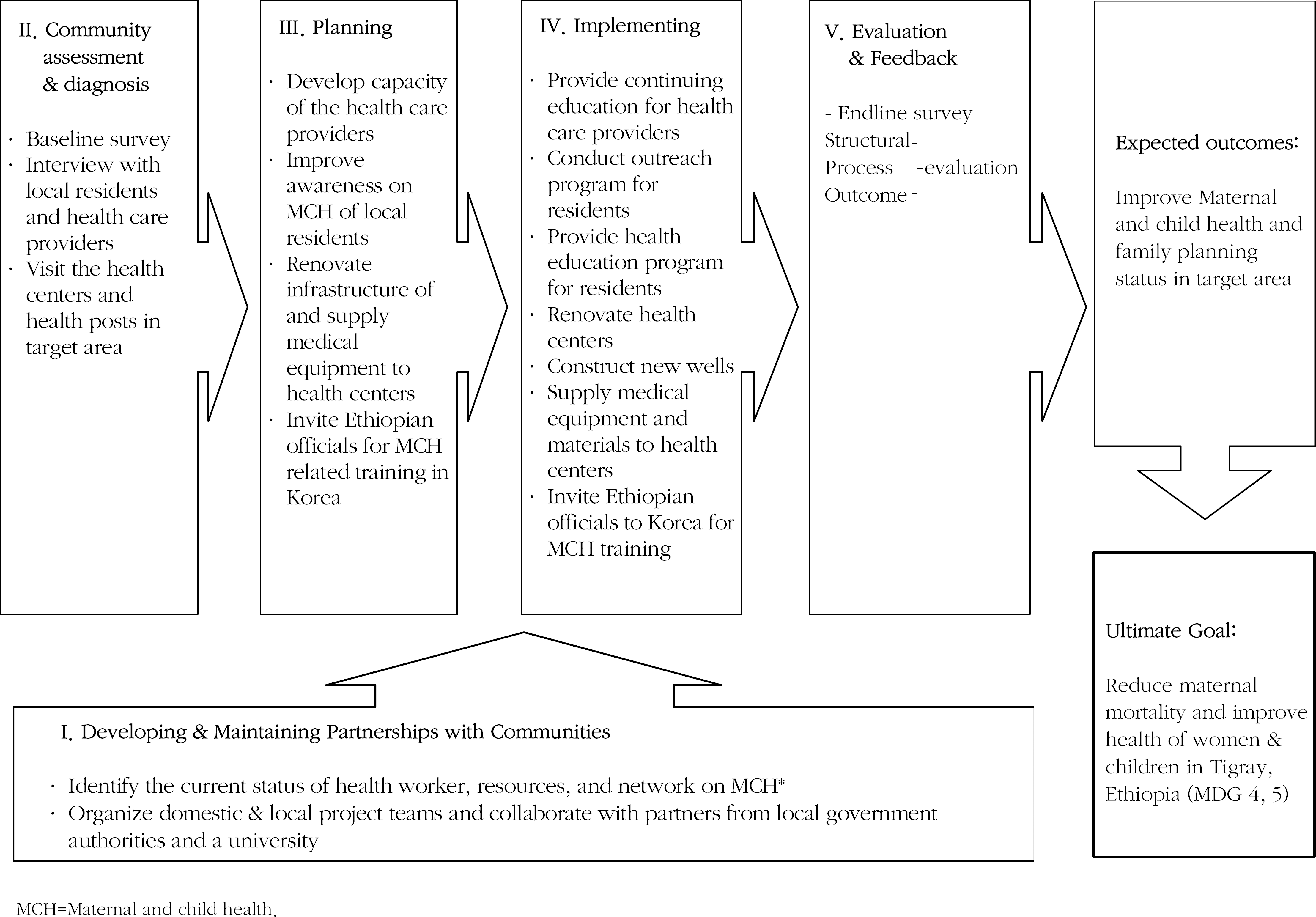Abstract
Purpose
The purposeof this studywastodemonstratea two-year global health projecttoimprovematernal and childhealth(MCH) inEthiopia.
Methods
This isadescriptivecasestudy. Thetarget areais Kilte AwlaeloWoreda inTigray Regional State, Ethiopia. A baseline survey was conductedto identify the needs of community residents and health careprof essionals. AMCH program was developed according to a project design matrix that included: infrastructure renovation of health centers; continuing education for midwives, nurses, andhealth extension work-ers(HEWs); andimprovement of residents'MCH awareness. Project evaluation willexaminethestructure, process, andoutcomesof the program.
Results
Thebaseline survey showedlow ratesof family planning(31%) and antenatal andpostnatalcare use (36.1%and69%, respectively). Theinstitutionalbirthratewas 13.5%. Midwives andnursesreceived 2∼4educational programsabout familyplanning andperinatal care. HEWswere alsogiven practical education. Water and electrical infrastructureof all five health centersintheKilteAwlaeloWoredawere renovated. Additionally, medical supplies and equipment were provided. Communityhealtheducation onperinatal care, family planning, and personal hygienewas presented.
Go to : 
References
1. WHO.int [Internet]. Geneva: Global Health Observatory-Maternal mortality;; [cited 2013 Nov 21]. Available from:. http://www.who.int/gho/maternal_health/mortality/maternal_mortality_text/en/index.html.
2. WHO.int [Internet]. Geneva: Global Health Observatory-Under-five mortality;; [cited 2013 Nov 21]. Available from:. http://www.who.int/gho/child_health/mortality/mortality_under_five_text/en/index.html.
3. Likis FE. Midwives are essential to global maternal and child health. J Midwifery Womens Health. 2011; 56(5):425–6. http://dx.doi.org/10.1111/j.1542–2011.2011.00114.x.

4. Hogan MC, ForemanKJ , Naghavi M, Ahn SY, Wang M, Makela SM, et al. Maternal mortality for 181 countries, 1980–2008: a systematic analysis of progress towards Millennium Development Goal 5. Lancet. 2010; 375(9726):1609–23. http://dx.doi.org/10.1016/S0140-6736(10)60518–1.

5. Moyer CA, Adanu RM, Engmann CM. The relationship betweenfacility-based deliveryandmaternalandneonatalmortality in Sub-Saharan Africa. Int J Gynaecol Obstet. 2013; 122(3):263–5. http://dx.doi.org/10.1016/j.ijgo.2013.04.010.
6. Horton R. Maternal mortality: surprise, hope, and urgent action. Lancet. 2010; 375(9726):1581–2. http://dx.doi.org/10.1016/S0140–6736(10)60547–8.

7. Fullerton JT, Johnson PG, Thompson JB, Vivio D. Quality considerations in midwifery pre-service education: exemplars from Africa. Midwifery. 2011; 27(3):308–15. http://dx.doi.org/10.1016/j.midw.2010.10.011.

8. Nkowane AM, Boualam L, Haithami S, El Sayed el TA, Mutambo H. The role of nurses and midwives in polio eradication and measles control activities: a survey in Sudan and Zambia. Hum Resour Health. 2009; 7:78. http://dx.doi.org/10.1186/1478-4491–7–78.

9. Kruk ME, Pacz kowski MM, Tegegn A, Tessema F, Hadley C, AsefaM , et al. Women ‘spreferences for obstetric carein rural Ethiopia: a population-based discrete choice experiment in a region with low rates of facility delivery. J Epidemiol Community Health. 2010; 64(11):984–8. http://dx.doi.org/10.1136/jech.2009.087973.
10. Reutter L, Kushner KE. 'Health equity through action on the social determinants of health': taking upthe challenge in nursing. Nurs Inq. 2010; 17(3):269–80. http://dx.doi.org/10.1111/j.1440–1800.2010.00500.x.
11. Pitt C, Greco G, Powell-Jackson T, Mills A. Countdown to 2015: assessment of official development assistance to maternal, newborn, and child health, 2003–08. The Lancet. 376 (. 9751. ): 1485–96.http://dx.doi.org/10.1016/S0140-6736(10)61302-5.
12. KOICA.go.kr [Internet]. Kyunggi-do: KOICA; [updated 2013 Jun 4; cited 2013 Sep 27]. Available from:. http://www.koica.go.kr.
13. Dayilypharm.com [Internet]. Seoul: Dayily pharm;c1999. -2012 [updated 2013 Apr 2; cited 2013 Sep 27]. Available from:. http://www.dailypharm.com/News/169187.
14. Lee H, LeeT, Shin H, Ahn H, Kim M, Lee M.Patterns andpre-dictors of non-use of family planning methods in Ethiopian women: a panel survey. Int Nurs Rev. 2013; 60(3):335–43. http://dx.doi.org/10.1111/inr.12028.
15. Forsetlund L, Bjorndal A, Rashidian A, Jamtvedt G, O'Brien MA, Wolf F, et al. Continuing education meetings and workshops: effects on professional practice and health care outcomes. Cochrane Database Syst Rev. 2009(2):): CD003030.http://dx.doi.org/10.1002/14651858.CD003030.pub2.

16. Kitaw Y, Ye-Ebiyo Y, Said A, Desta H, Teklehaimanot A. Assessment of the training of thefirstintake of Health Extension Workers. Ethiop J Health Dev. 2007; 21(3):232–9.

17. Shin H, Kim E, Yoo B, Lee H. Development of a community-based participatory global health project model for primary health care capacity development: a case study from a rural communit yin Ecuador. JKorean Acad Community Health Nurs. 2010; 21(1):31–42. http://dx.doi.org/10.12799/jkachn.2010.21.1.31.
Go to : 
Table 1.
On-the-Job Training Schedule for Health Care Professionals
Table 2.
Comparison of Knowledge and Competency in Each Training Courses




 PDF
PDF ePub
ePub Citation
Citation Print
Print



 XML Download
XML Download